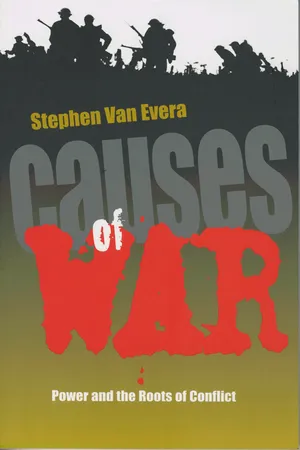
- 278 pages
- English
- ePUB (mobile friendly)
- Available on iOS & Android
About this book
What causes war? How can military conflicts best be prevented? In this book, Stephen Van Evera frames five conditions that increase the risk of interstate war: false optimism about the likely outcome of a war, a first-strike advantage, fluctuation in the relative power of states, circumstances that allow nations to parlay one conquest into another, and circumstances that make conquest easy.
According to Van Evera, all but one of these conditions—false optimism—rarely occur today, but policymakers often erroneously believe in their existence. He argues that these misperceptions are responsible for many modern wars, and explores both World Wars, the Korean War, and the 1967 Mideast War as test cases. Finally, he assesses the possibility of nuclear war by applying all five hypotheses to its potential onset. Van Evera's book demonstrates that ideas from the Realist paradigm can offer strong explanations for international conflict and valuable prescriptions for its control.
Frequently asked questions
- Essential is ideal for learners and professionals who enjoy exploring a wide range of subjects. Access the Essential Library with 800,000+ trusted titles and best-sellers across business, personal growth, and the humanities. Includes unlimited reading time and Standard Read Aloud voice.
- Complete: Perfect for advanced learners and researchers needing full, unrestricted access. Unlock 1.4M+ books across hundreds of subjects, including academic and specialized titles. The Complete Plan also includes advanced features like Premium Read Aloud and Research Assistant.
Please note we cannot support devices running on iOS 13 and Android 7 or earlier. Learn more about using the app.
Information
Table of contents
- Tables and Diagrams
- Acknowledgments
- 1. Introduction
- 2. False Optimism: Illusions of the Coming War
- 3. Jumping the Gun: First-Move Advantages and Crisis Instability
- 4. Power Shifts: Windows of Opportunity and Vulnerability
- 5. Cumulative Resources
- 6. Offense, Defense, and the Security Dilemma
- 7. Offense-Defense Theory and the Outbreak of World War I
- 8. The Nuclear Revolution and the Causes of War
- 9. Conclusion
- Appendix: Hypotheses on Power and the Causes of War